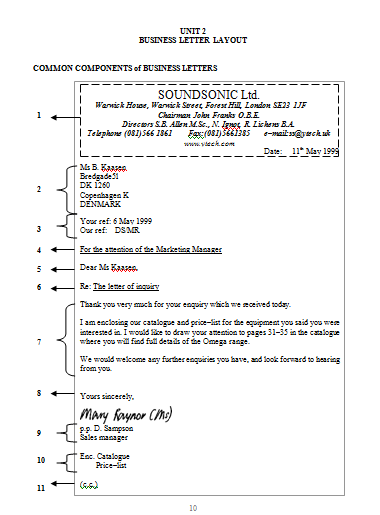
- •An introduction to business writing
- •Content and style in business correspondence
- •1. State the main business, purpose, or subject matter right away.
- •Keep the paragraphs of most business letters short.
- •Sales letters
- •Identify the Problem
- •Inject Scarcity:
- •Opening lines
- •Indicating the state of the market
- •Closing sentences
- •Invoices
An introduction to business writing
BUSINESS LETTER LAYOUT

Letterhead with the Sender’s or Return Address and the date
Inside Address
References
Attention Line / Private or Confidential
Salutation
Subject Line
Body
Complimentary Close
Signatures
Enclosure Lines
Copy Line
Content and style in business correspondence
1. State the main business, purpose, or subject matter right away.
Keep the paragraphs of most business letters short.
"Compartmentalize" the contents of your letter. When you "compartmentalize" the contents of a business letter, you place each different segment of the discussion — each different topic of the letter — in its own paragraph.
Place important information strategically in business letters. Information in the first and last lines of paragraphs tends to be read and remembered better
Find positive ways to express bad news in your business letters.
Focus on the recipient's needs, purposes, or interests instead of your own.
Give your business letter an "action ending" whenever appropriate. An "action–ending" makes clear what the writer of the letter expects the recipient to do and when. "Hope to hear from you soon" or "Let me know if I can be of any further assistance." Instead, or in addition, specify the action the recipient should take and the schedule for that action.
Length
as long as necessary and this will depend on the subject of the letter;
Keep your sentence average length low
an average sentence length of between 15 and 20 words.
11. Use simple words rather than complex ones
12. Order and sequence
As well as containing the right amount of information, your letter should also make all the necessary points in a logical sequence, with each idea or piece of information linking up with the previous one in a pattern that can be followed. Do not jump around making a statement, switching to other subjects, then referring back to the point you made a few sentences or paragraphs before.
13. Use active verbs rather than passive verbs
14. Prepositions
Special care should be taken when using prepositions. There is a big difference between “The price has been increased to £15.00”, “The price has been increased by £15.00”, and “The price has been increased from £15.00”.
Follow the seven c's. Each letter/memorandum should be:
Clear
Concise
Correct
Courteous
Conversational
Convincing
Complete
MEMO
To:
From:
Date:
Subject:
Define the problem.
Tell the reader why they should feel concerned.
Say what result you want to get.
Say what you want the reader to do and when.
purpose statement
summary
discussion
action
purpose of memo
summary
problem leading to the decision to perform the procedure
methods
results
conclusions
recommendations
